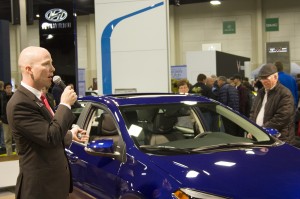
The average auto show features slick cars, eco-friendly engines and even a few concept models.
This year’s International Auto Expo in Sandy looked more like the Consumer Electronics Show than a celebration of automotives. Technological innovations were certainly the highlight of the show, including built-in WiFi, smartphone apps and even inflatable rear seat belts. None of these features were new, but most of them were released to more affordable cars like the Ford Taurus and the Toyota Corolla.
“You’re seeing more and more of the technology available on all levels of vehicles, even entry-levels,” said DeeDee Taft, spokeswoman for the Motor Trend auto shows.
Most of these modernizations are not standard or required by federal regulation, but this doesn’t mean they aren’t becoming the norm for newer models. Touch screens, navigation and even rear-view cameras are quickly becoming basic entries in most car models.
Craig Bickmore, executive director of new car dealers of Utah, said the slew of technological advances is how manufacturers catch the slight lead over each other.
“Cars are all good. It’s a razor’s edge between cars in terms of quality,” Bickmore said. “Technology has moved things, so it’s a race to the finish. And it’s a photo finish.”
The new models are unique. They include all the bells and whistles, or at least most of them, and they are all pretty affordable. Courtney Wight, a representative for Chevrolet, said it’s great to see cars with WiFi and built-in apps becoming more widely available. Bickmore agreed; technology is assisting in the advancement of performance and the driving experience.
“The average age of a fleet is 11.1 years. Cars are aging,” Bickmore said. “Those are features to sell. We’re just on the eve of those kind of things. Watch what’s coming up.”
The economy is coming up, as have auto sales. Nationally, new car sales are up eight percent, according to Motor Intelligence, a statistical gathering site for the auto industry. This percentage means more people are buying new cars rather than used or not buying a car at all. For Utah, Bickmore said auto sales are up nine percent. It is just one percentage point, but Bickmore said it still represents better economic growth and development for Utah when compared to the rest of the nation.
In addition to the gadgets lining the dashboard of most new cars, a more prominent trend in cars is the green movement and the push for more miles per gallon. In 2004, the average car went about 22 miles for every gallon, according to the U.S. Department of Energy. The average 2013 model got around 30 miles per gallon. This stark increase isn’t limited to just subcompacts or mid-size hybrids. Every size of car is improving in fuel efficiency and in emissions.
“Any new car is a clean car because technology has advanced so much,” Taft said. “That’s really the trend. … Even if you want a big truck like the Ford F-150, even that’s made of partially substainable materials, recycled soybeans, t-shirts and jeans. And it’s also … way better than it was before. … I think it’s 17 or 18 miles per gallon. It’s better than it was.”
Bickmore said the poor air quality consistent with Utah should be a motivator for car buyers to go green.
“Some of these new cars, the exhaust coming out is as clean as the air coming in,” Bickmore said. “If we want to clear up the air … it does make sense to purchase a new car with that new technology.”
More features made widely available displayed at the show include lane assistance, accident avoidance sensors and engine start-stop systems. Safety, efficiency and technological advancement are the focus points for manufacturers for the future of automobiles.
“If you’ve been sitting on a car for a while, maybe now’s the time,” Taft said. “Get something new, something clean, something more efficient.”




